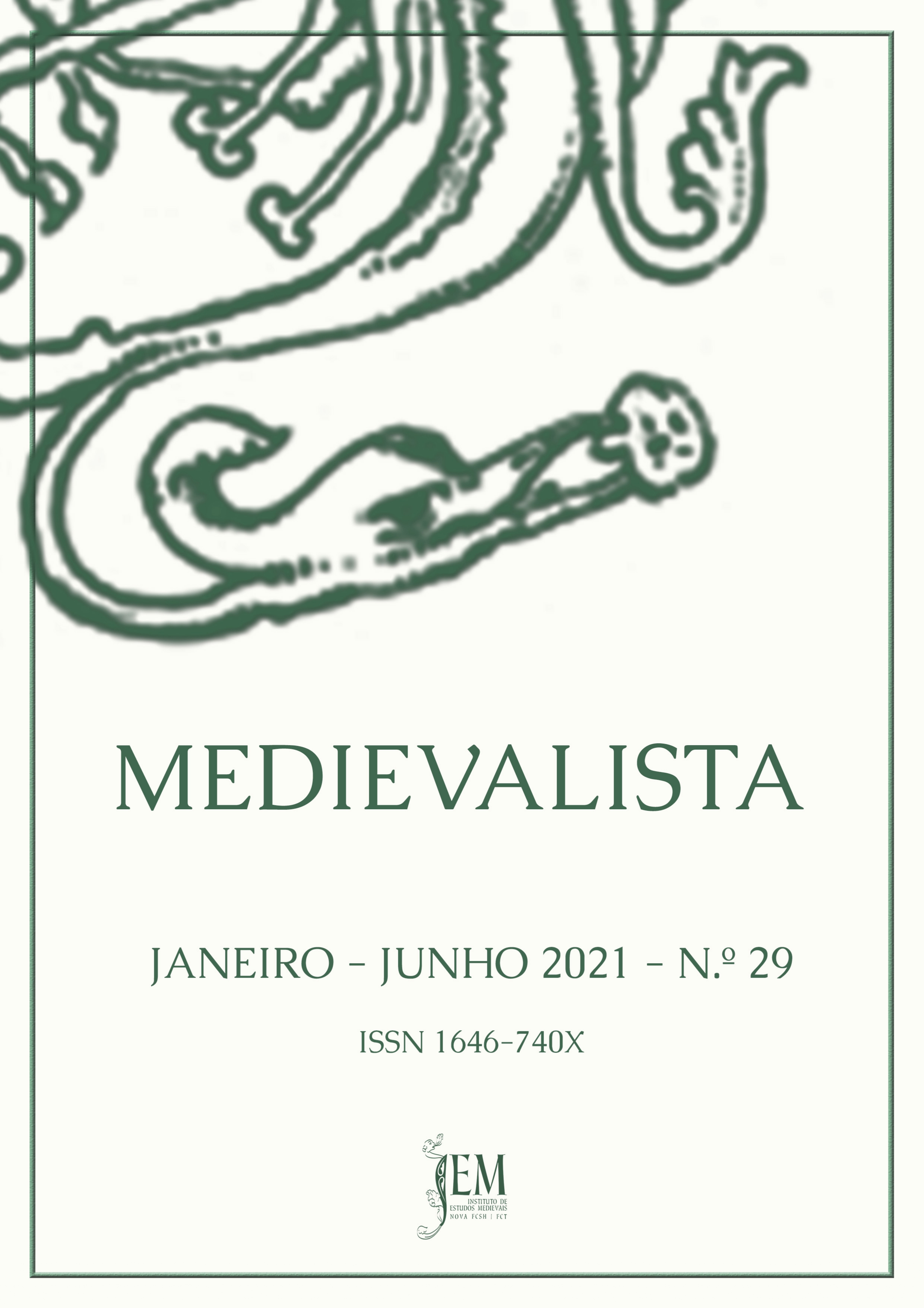Rise and fall of beasts: evolution of animal allegory in the Middle Ages
DOI:
https://doi.org/10.4000/medievalista.3887Keywords:
Allegory, Bestiary, Platonism, Aristotelianism, Middle AgesAbstract
Most of the history of medieval thought was influenced by Platonism and the reworkings that the Latin and Greek Fathers made of Plato's doctrines. The worldview resulting from this thought considered that each manifestation of the sensible world, while participating in the nature of God, was the opportunity to access transcendent knowledge. Among these manifestations, animals played a prominent role. Zoological knowledge inherited from classical antiquity was given new meaning and enriched through an exegesis that transformed beasts into examples that illustrated aspects of Christian doctrine or provided models of moral conduct. The Physiologus and its derivatives, the medieval bestiaries are an example of this interpretive practice, which for these texts was based primarily on allegory. In this article, we propose to see how and with what objectives it was applied to animals and we will inquire about the evolution of animal symbolism in the framework of the decline of Platonism and the rise of Aristotelianism in the last centuries of the Middle Ages. For this, we will analyze a brief corpus, composed of the beaver, the weasel, the oyster and the pearl, and the elephant.
Bibliography
Handwritten sources
DIGITAL BODLEIAN, Ms. Bodley 602 fol.34r [en línea] [consultado el 30 diciembre 2019]. Disponible en https://digital.bodleian.ox.ac.uk/inquire/p/72b4cc9e-128b-4969-a39b-9d29875bc33b.
THE J. PAUL GETTY MUSEUM COLLECTION, Ms. Ludwig XV 3 (83.MR.173), fol. 83 [en línea] [consultado el 20 diciembre 2019]. Disponible en http://www.getty.edu/art/collection/objects/4806/unknown-maker-a-hunter-blowing-his-horn-and-a-beaver-franco-flemish-about-1270/?dz=0.5000,0.6130,0.92.
THE MORGAN LIBRARY AND MUSEUM, Ms. M.459 fol. 7v [en línea] [consultado el 30 diciembre 2019]. Disponible en http://ica.themorgan.org/manuscript/page/14/145750.
WIKIMEDIA COMMONS CONTRIBUTORS, File: Matthew Paris Elephant from Parker MS 16 fol 151v.jpg [en línea]. Wikimedia Commons, the free media repository, 2018 [consultado el 31 diciembre 2019]. Disponible en https://commons.wikimedia.org/w/index.php?title=File:Matthew_Paris_Elephant_from_Parker_MS_16_fol_151v.jpg&oldid=326905485.
WIKIMEDIA COMMONS CONTRIBUTORS. File:83-Oxford Bodley 764- Elefante.jpg [en línea]. Wikimedia Commons, the free media repository, 2016 [consultado 31 diciembre 2019]. Disponible en https://commons.wikimedia.org/w/index.php?title=File:83-Oxford_Bodley_764-_Elefante.jpg&oldid=196331031.
WIKIMEDIA COMMONS CONTRIBUTORS. File: Sloane278 f.48v Elephants, Dragon, And Mandrake.jpg [en línea]. Wikimedia Commons, the free media repository, 2015 [consultado el 31 diciembre 2019]. Disponible en https://commons.wikimedia.org/w/index.php?title=File:Sloane278_f.48v_Elephants,Dragon,AndMandrake.jpg&oldid=154968818.
Printed sources
ARFE, Juan – Bestiario. Introducción Isabel Muñoz Jiménez. Madrid: Medusa, 2002.
ARISTÓTELES − Investigación sobre los animales. Introducción Carlos García Gual, traducción y notas Julio Pallí Bonet. Madrid: Gredos, 1992.
El Fisiólogo. Bestiario medieval. Ed. Nilda Guglielmi. Madrid: Eneida, 2002.
ELIANO, Claudio − Historia de los animales. Libros I-VIII. Ed. José María Díaz Regañón López. Madrid: Gredos, 1984.
FOURNIVAL, Richard − Bestiario de amor. Madrid: Miraguano, 1999.
GÓNGORA, Luis − Poesía: Soledades, Fábula de Polifemo y Galatea, Panegírico Al Duque de Lerma y Otros Poemas. Madrid: Taurus, 1981.
GRANADA, Luis de − Introducción del símbolo de la Fe (selección). in GAOS, José (selección, estudio preliminar y notas) − Escritores místicos españoles. Buenos Aires: Editorial Jackson, 1952.
LAGUNA Andrés − Bestiario de Dioscórides. Introducción y notas Carlos Ferrándiz Madrigal. Madrid: Medusa, 2001.
MALAXECHEVERRÍA, Ignacio − Bestiario medieval. Madrid: Siruela, 1999.
MŪSĀ B. ‘UBAID ALLĀH AL-QURTUBI AL-ISRĀ’ILI (Maimónides) − Maqala Tashtamil Ala Fusul Min Kitab Al-Hayawan Li-Aristu (Tract comprising Excerpts from Aristotles Book of Animals). Ed. y trad. John Nicholas Mattock en Arabics Technical and Scientific Texts. Vol. 2. Cambridge: Cambridge Middle East Centre, 1966.
NAUGHTON, Virginia (trad.) − Bestiario medieval. Buenos Aires: Quadrata, 2005
PLINIO SEGUNDO, Cayo − Historia natural. Libros II-IV. Coord. Ana María Moure Casas. Madrid: Gredos, 2003.
PLINIO SEGUNDO, Cayo − Historia natural. Libros VII-X. Coord. Ana María Moure Casas. Madrid: Gredos, 2003.
SAN ISIDORO DE SEVILLA – Etimologías. Eds. José Oroz Reta y Manuel Marcos Casquero. Madrid: Biblioteca de Autores Cristianos, 2004.
Studies
AUERBACH, Erich – Figura. Madrid: Trotta, 1998.
CLARK, Willene B., MCMUNN, Meredith T (eds.) − Beasts and Birds of the Middle Ages: the bestiary and its legacy. Filadelfia: University of Pennsylvania, 1989.
DOCAMPO ÁLVAREZ, Pilar, MARTÍNEZ OSENDE, Javier, VILLAR VIDAL, José Antonio − “La versión C del Fisiólogo latino: el Codex bongarsianus 318 de Berna”. Medievalismo [en línea] 10 (2000), pp. 27-67. [Consultado el 19 diciembre 2019]. Disponible en http://revistas.um.es/medievalismo/article/view/51801.
ELIADE, Mircea − Imagen y símbolo. Madrid: Taurus, 1999.
ELIADE, Mircea − Tratado de Historia de las Religiones. Madrid: Ediciones Cristiandad, 2000.
FERRERO HERNÁNDEZ, Cándida − Liber contra venena et animalia venenosa. Estudio preliminar, edición crítica y traducción, (tesis doctoral). Barcelona: Universitat Autònoma de Barcelona, 2002. [consultado el 27 diciembre 2019]. Disponible en https://www.tdx.cat/handle/10803/5536.
GILSON, Étienne − La filosofía en la Edad Media. Madrid: Gredos, 1995.
GONZÁLEZ HERNANDO, Irene – “El fruto del deseo: connotaciones sexuales de la mandrágora desde Egipto hasta la Edad Media”. Revista Digital de Iconografía Medieval [en línea] IX/17 (2017), pp. 61-79. [Consultado el 27 diciembre 2019]. Disponible en https://www.ucm.es/bdiconografiamedieval/numero-17.
GONZÁLEZ HERNANDO, Irene; HERNÁNDEZ PÉREZ, Azucena – “Mandrágora”. in Base de datos digital de iconografía medieval [en línea]. Madrid: Universidad Complutense de Madrid, 2013. [consultado el 27 diciembre 2019]. Disponible en https://www.ucm.es/bdiconografiamedieval/la-mandragora.
KUHRY, Emmanuelle − “Panorama des manuscrits et nouvelles ressources pour l’étude de la tradition manuscrite du Physiologus latin”. RursuSpicae [En línea] 2 (2019) [Consultado 20 de diciembre 2019]. Disponible en http://journals.openedition.org/rursuspicae/924.
LAUSBERG, Heinrich − Manual de retórica literaria. Madrid: Gredos, 1966.
LAZARIS, Stavros − Le Physiologus grec : la réécriture de l’histoire naturelle antique. Florencia: Sismel, 2016.
ORÍGENES − Comentario al Cantar de los Cantares. Trad. Argimiro Velasco. Madrid: Ciudad Nueva, 2007.
SAINTYVES, Pierre − L'astrologie populaire étudiée spécialement dans les doctrines et les traditions relatives à l'influence de la lune Essai sur la méthode dans l'étude du Folklore des opinions et des croyances. Librairie Emile Nourry: París, 1937.
UNIVERSITY OF CAMBRIDGE − Elephants and humans: a love affair over 1300 years [en línea] 2015. [Consultado el 20 diciembre 2019]. Disponible en https://www.cam.ac.uk/research/features/elephants-and-humans-a-love-affair-over-1300-years.
VARVARO, Alberto − Literatura románica de la Edad Media. Barcelona: Ariel, 1983.
ZAMBÓN, Francesco − El alfabeto simbólico de los animales. Los bestiarios de la Edad Media. Madrid: Siruela, 2010.
Downloads
Downloads
Published
How to Cite
Issue
Section
License
Copyright (c) 2024 Medievalista

This work is licensed under a Creative Commons Attribution 4.0 International License.





















